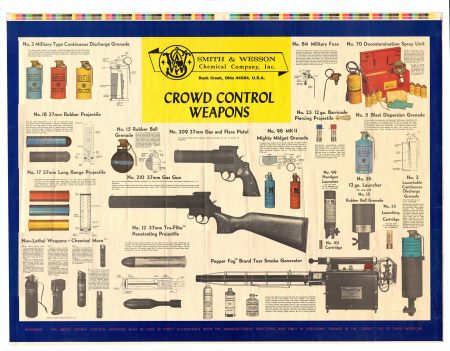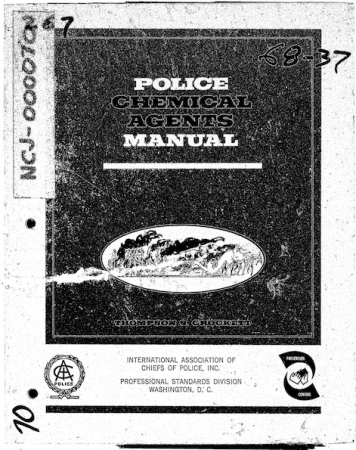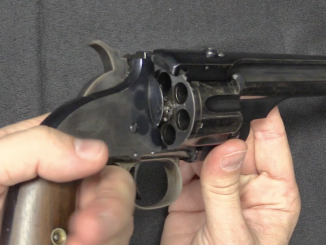The Smith & Wesson company was purchased by the Bangor Punta conglomerate in 1964, and BP also owned one of the early pioneers in police tear gas products, the Lake Erie Chemical Company. Once it had both companies under single ownership, the decision was made to rebrand the tear gas product line as the Smith & Wesson Chemical Company. S&W was obviously a brand with lots of recognition in law enforcement, so this was a good idea. S&W began production of a new model of 37mm tear gas launcher using the N frame revolver clockwork, coupled with a simple break action barrel. The system was available as either a pistol (7.5 inch barrel) or a stocked carbine (14 inch barrel) – and a nautical line-throwing version was also made. This is probably the finest quality tear gas or flare gun ever made, as the clockwork from the revolvers gives it a great single action and double action trigger pull compared to the typical utilitarian flare gun.
A variety of projectiles were made, including short-range, long-range, and barrier penetrating models (see poster below). These were all available loaded with smoke, CS, or CN gas. Production appears to have ceased in 1984, when the Bangor Punta conglomerate was bought out, and Smith & Wesson sold off from it shortly thereafter.
Source of the quote about Roush:
https://archive.org/details/strikestrategy00steurich/page/8/mode/2up





When I was a police officer (circa 1898), my department had a supply of S&W gas guns and projectiles. I got to fire one once. Excellent made gun.
I think you meant 1988 or 1998, not 1898.
David Correia and Tyler Wall, _Police: A Field Guide_ (Verso, 2018):
https://www.versobooks.com/books/2530-police
Anna Feigenbaum, _Tear Gas: From the Battlefields of World War I to the Streets of Today_ (Verson, 2017):
https://www.versobooks.com/books/2109-tear-gas
Some of the earliest use of tear gas was in France before WW1. When the French police were pursuing the Bonnot Gang, a group of anarchists who specialized in robbing bank messengers;
https://libcom.org/files/Richard%20Parry%20-%20The%20Bonnot%20Gang.pdf
Before using tear gas, when they had two of the gang’s leaders cornered in a house, the police tried to make a “forced entry” by using dynamite to breach a stucco back wall.
Unfortunately, being anarchists, the gangsters had their own store of dynamite- that happened to be on the other side of the same wall.
The result was sort of like the famous “Think you used enough dynamite there, Butch?” incident with the Wild Bunch. The two anarchists, and about half the house, did not survive it.
Oops.
cheers
eon
I think we had some in the prison armories here( Georgia). I was only responsible for maintaining inventory on them and their ammunition, and we never needed them in my career. Something like that could remain on hand for decades without needing replacement.
It seems that they were made more elegant.
http://www.fototime.com/2DB3DA918B0C7B3/orig.jpg
http://smith-wessonforum.com/firearms-knives-other-brands/218778-us-navy-hand-fired-flares.html
If you really want to know why it’s “less lethal” vice “nonlethal”, look up Victoria Snelgrove.
I recall that the Royal Ulster Constabulary used a similar large bore weapon during the Recent troubles. They were WWI surplus manufactured by I think Harrington & Richardson as grenade launchers. The RUC used then to launch rubber bullets. They were partially made of brass.
The “baton round” or plastic/ rubber bullet of the Troubles was the equivalent of shooting a D-cell battery out of one of these grenade launchers. The “idea” was to use them very far away, to target the lower extremities, and even to “skip” the baton off of the pavement into the riotous assembly to whom the “riot act” had been duly read out to as a warning vs. firing grape shot down the street.
In practice, none of this happened. As the Smith & Wesson poster puts it: “… MUST BE USED IN STRICT ACCORDANCE WITH THE MANUFACTURER’S DIRECTIONS AND ONLY BY PERSONNEL TRAINED IN THE CORRECT USE OF THE WEAPONS.” So the “less than lethal” proved to be all too lethal then as now… Or put out people’s eyes and so on. Check out the numbers of people killed by “baton rounds” some time…
It’s easy for the manufacturer to say “don’t aim at their faces” when the faces in question disobey the order to “come no closer.” It’s worse when the crowd is composed of people threatening to bash you to death with HUGE ROCKS. I could be wrong.
There is a current debate about police role in such event : the German police used to use a de-escalation approach by communicating with protested (with arsenal ready but not displayed). It worked rather well.
Reverse example for the G20 in Hamburg (2017)
Hamburg was know to host autonomous organizations. Authorities were warned to not hold such summit so close to their opponents headquarters. A real bad idea.
The choice was maintained and the police teams were pushed to display and use force first instead of de-escalating tension. There were about 300 protesters who refused to display their face. The organizer of the protest requested the police a bit of time to try to convince those protesters but it was refused because the police had orders to go fast with force.
The protester were quickly bashed & pushed back with water cannons. The images revolted the people and it backfired the next days as more people came to protest and more violently.
Similarly, in France during the Yellow jacket, the situation was difficult : for savings, the police forces have been highly reduced. Units not trained for crowd control were employed and shit happened : the one who were not trained properly for using heavy rubber rounds were the one who used the most rubber rounds.
One tactic used was encircling the crowd and isolating it. (the protest march plan shared in advance by protesters and validated by officials allow the protest to march to a defined route and then disperse.) Then in reality, a dead end was set by anti-riot forces : the protester were blocked, pushed by the one arriving and had no exit to disperse. Guess what? Tension increased. And they were “dispersed” by heavy rubber projectiles, sting-ball grenades and stuff, without anywhere open to leave. The image came out and even more people were disgusted & angry 🙂
Where is the bayonet lug
So many people were hurt in France by the 40mm launchers that BRUGGER and THOMAT the makers of the launcher had to post an acuracy test on their website as the police were saying that the head shots were due to the launchers inacuracy . They also posted that the wounds were due to the police using more powerful 40mm rounds then the B T ones They should have stuck to the verney carnon flashballs which were also made in France
All these “less lethal” bullets for riot control, this is bullshit. They only add excitement and aggression.
If there are sufficient formal grounds for the use of life-threatening assets, “normal” bullets should be used immediately.
In all other cases, you should use funds that are truly safe for the health of the average person. Such as water, glue, sound, paint, gas, tasers, ets.
The ideal “riot control” munition would be something like Spider-man’s webbing. A long-chain molecule polymer that could be sprayed from a nozzle like a water cannon’s, and form a net, rather like Silly String. Except once exposed to air, it quickly toughens and becomes like very strong nylon webbing, with high adhesion qualities.
You’d theoretically end up with the rioters stuck to the pavement, to buildings- and each other.
You could use a sprayed solvent to dissolve the polymer and release them. After a couple of hours.
In the interim, they might yell a lot, but they wouldn’t be throwing rocks or breaking things.
cheers
eon
The closest idea I can get to “stop them without hurting them” seems to be spraying soap suds everywhere and praying that none of the rioters are carrying huge rocks or flaming bottles of nastiness…
Ni-Ti… Nitinol; it… Well, shrinks and stuff. I don’t really understand the: It generates huge pressure vs it will snap thing.
E= Muddled, squared. Still if you did, might work.
Note that this launcher was made by a tear gas company. It was literally meant to launch gas.
Not that forgotten. Our Jail’s emergency response team is still using one of these. Supposedly it’s a hand-me-down from some time when SWAT got new gear.